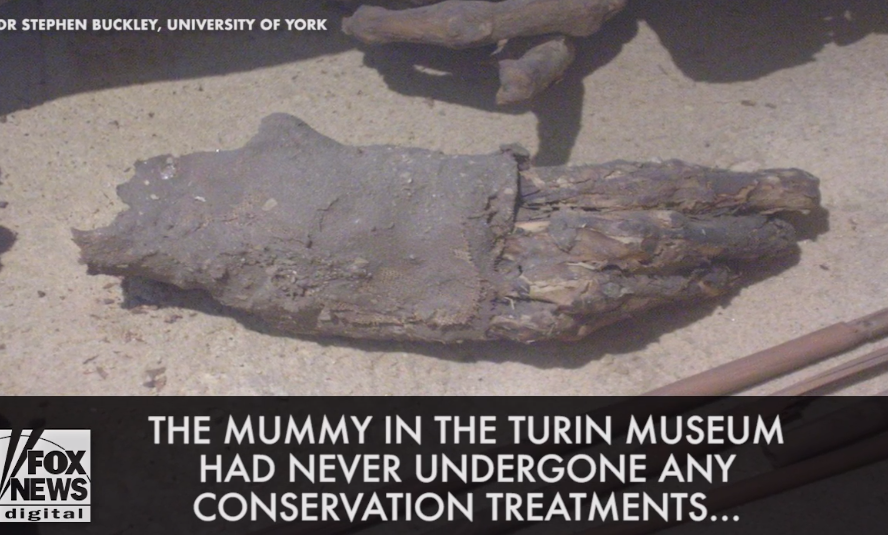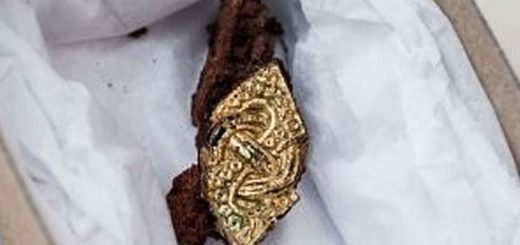Egyptian mummy reveals incredible embalming ‘recipe’

A mummy buried in Southern Egypt more than 5,000 years ago has revealed its grisly secrets, shedding new light on prehistoric embalming practices.
Researchers from the Universities of York, Oxford and Warwick in the U.K., Macquarie University in Australia, and the universities of Trento and Turin in Italy studied the mummy, which has been housed in the Egyptian Museum in Turin since 1901.
“It is the first time that extensive tests have been carried out on an intact prehistoric mummy,” explains the University of York, in a statement. The latest study backs up researchers’ previous findings that embalming was taking place 1,500 years earlier than previously thought.
STUNNING SPHINX DISCOVERY: WORKERS MAKE INCREDIBLE FIND WHILE FIXING ROAD
The mummy, which has been dated to around 3700 to 3500 BC, was thought to have been naturally mummified by Egypt’s hot, dry desert sand. However, scientists led by the Universities of York and Macquarie found that the mummy had actually been embalmed.
A ‘recipe’ of plant oil, heated conifer resin, an aromatic plant extract and a plant gum/sugar mixed together was used to impregnate the textiles in which the body was wrapped, according to the researchers.
Antibacterial agents were identified in the mixture. The agents were “used in similar proportions to those employed by the Egyptian embalmers when their skill was at its peak some 2,500 years later,” the scientists said.
MUMMY WEARING GOLD-GILDED FACE MASK DISCOVERED AT ANCIENT EGYPT BURIAL GROUND
A previous study in 2014 found complex embalming agents in linen fragments that were wrapped around bodies in a prehistoric tomb in Middle Egypt. The latest research indicates that the “embalming recipe” was used over a larger geographical area than previously thought.
“Having identified very similar embalming recipes in our previous research on prehistoric burials, this latest study provides both the first evidence for the wider geographical use of these balms and the first ever unequivocal scientific evidence for the use of embalming on an intact, prehistoric Egyptian mummy,” said archaeological chemist Dr. Stephen Buckley of the University of York.
Ancient Egypt continues to reveal its secrets. A mysterious sphinx, for example, has been discovered during roadwork in the Egyptian city of Luxor.
ARCHAEOLOGISTS IN EGYPT DISCOVER ANCIENT MUMMIFICATION WORKSHOP
“By combining chemical analysis with visual examination of the body, genetic investigations, radiocarbon dating and microscopic analysis of the linen wrappings, we confirmed that this ritual mummification process took place around 3600 BC on a male, aged between 20 and 30 years when he died,” said Dr. Jana Jones, an Egyptologist at Macquarie University, in a statement.
Archaeologists recently opened a ‘cursed’ ancient black granite sarcophagus. In a separate project, experts also unearthed a 2,200-year-old gold coin depicting the ancient King Ptolemy III, an ancestor of the famed Cleopatra.
Experts in Southern Egypt recently discovered an extremely rare marble head depicting the Roman Emperor Marcus Aurelius.
MYSTERIOUS ANCIENT ARTWORK DEPICTING FEMALE PHARAOH FOUND BY ACCIDENT
Additionally, experts in Australia found the tattered remains of an ancient priestess in a 2,500-year-old Egyptian coffin that was long thought to be empty.
On the other side of the world, a rare ancient artifact depicting the famous female pharaoh Hatshepsut surfaced in the U.K. Stunning new research also claims that King Tutankhamun may have been a boy soldier, challenging the theory he was a weak and sickly youth before his mysterious death at around 18 years of age.
Experts in the U.K. also found the world’s oldest figurative tattoos on two ancient Egyptian mummies recently, one of which is the oldest tattooed female ever discovered.
RARE ROMAN DISCOVERY THRILLS EXPERTS: EMPEROR’S MARBLE HEAD FOUND AT EGYPTIAN TEMPLE SITE
Other recent finds include an ancient cemetery in Egypt with more than 40 mummies and a necklace containing a “message from the afterlife.” An ancient statue of a Nubian king with an inscription written in Egyptian hieroglyphics was also found at a Nile River temple in Sudan.
Scientists also believe that they may have found the secret of the Great Pyramid’s near-perfect alignment. Experts are also confident that they have solved the long-standing mystery of the “screaming mummy.”
In February, archaeologists announced the discovery of a 4,400-year-old tomb near the pyramids. Late last year, archaeologists also revealed that they had uncovered the graves of four children at an ancient site in Egypt.



 Creators of mankind
Creators of mankind Description of “Tall white aliens”
Description of “Tall white aliens” Where they came from?
Where they came from? About hostile civilizations
About hostile civilizations The war for the Earth
The war for the Earth “Tall white aliens” about eternal life
“Tall white aliens” about eternal life Video: “Nordic aliens”
Video: “Nordic aliens” Aliens
Aliens Alien encounters
Alien encounters The aliens base
The aliens base UFO
UFO Technology UFO
Technology UFO Underground civilization
Underground civilization Ancient alien artifacts
Ancient alien artifacts Military and UFO
Military and UFO Mysteries and hypotheses
Mysteries and hypotheses Scientific facts
Scientific facts


















